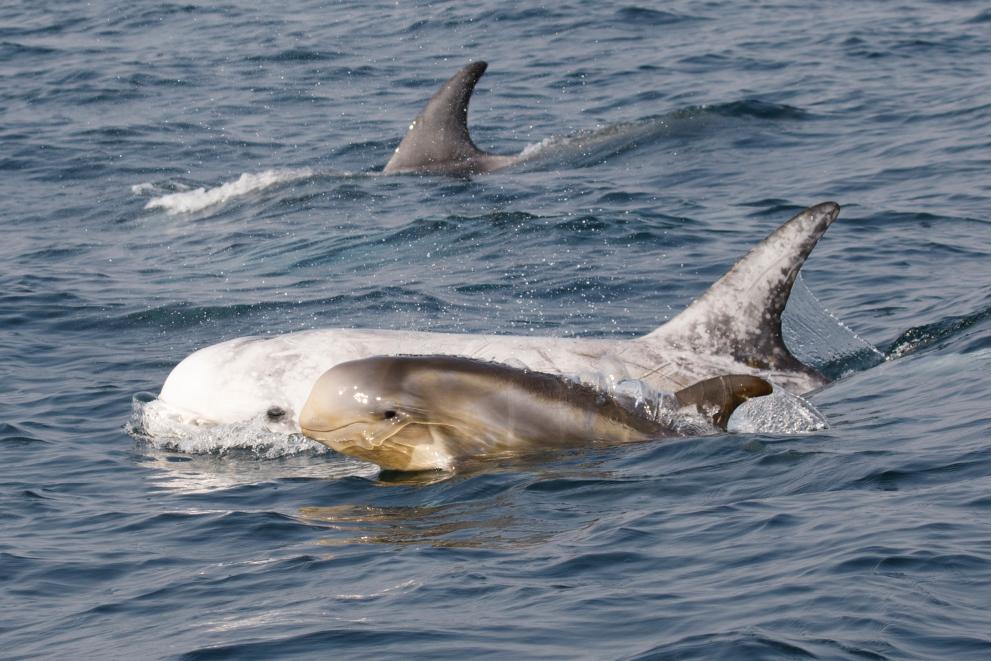
These dolphins are sensitive to environmental contaminants. This study tested dolphin samples from Italy for the presence of 3 banned toxic chemicals – all persistent organic pollutants (POPs).
Cetaceans, especially dolphins such as Grampus griseus, are particularly prone to build up of persistent chemical toxic substances, as they are apex predators (at the top of the marine food web), in this case consuming largely cephalopods (a group, including octopuses and squid, known to bioaccumulate organochlorines). As such, Risso’s dolphin can be considered an indicator species for chemical pollutants present in the Mediterranean Sea. Despite this, ecotoxicological and pathological research on this species of dolphin is scarce for the global population, as well as for the Mediterranean subpopulation.
By taking samples of blubber to assess the presence and levels of toxic chemicals, such as POPs, from dead dolphins found stranded along the coast of Italy, comparisons can then be made with toxicological results from the global population. Ecotoxicological status of this species in the Mediterranean Sea, alongside population data, can inform future regulatory and conservation measures, to protect this genetically distinct subpopulation of Risso’s dolphin. At present there are no specific conservation measures for Risso's dolphins in the Mediterranean, though the species is classed as threatened by the International Union for Conservation of Nature (IUCN).
The researchers took samples of tissues and organs from 20 stranded dolphins, from a time period spanning 1998 to 2021, along the Italian coasts. They tested for the presence of toxic contaminants, particularly organochlorines, such as hexachlorobenzene (HCB), polychlorinated biphenyls (PCBs), dichlorodiphenyltrichloroethane and its metabolites (DDTs) in samples of blubber, liver, muscle and brain. Sample data regarding contaminants was analysed with sex, age and stranding locations to note any correlations. Patterns of isomers of DDT, and isomers of PCBs with different chlorine content were detected in the samples. Ratios of DDTs to PCBs can help give information of origin of the pollutants, whilst the principal metabolite of DDT, dichlorodiphenyldichloroethylene (ppDDE), to DDT ratio helps identify how long ago the contaminant dates from.
The analysis showed all three classes of organochlorines were present, with HCB at the lowest level, followed by DDTs, and PCBs found at the highest levels in all the stranded Risso’s dolphins examined. Male dolphins had higher levels of contaminants, while females had lower, which the authors suggest could be due to females being able to unload pollutants during gestation and lactation to their offspring. The Stockholm Convention has regulated these contaminants at a global level since 2001.
The authors suggest the presence of these environmental pollutants poses a threat to resident Mediterranean cetaceans, determining the downward population trend of the Risso’s dolphin sub-species population in Europe, compared with higher numbers globally. The ratio of isomers1 of contaminants showed that no new contamination from the insecticide DDT had occurred, and it was historical contamination. Levels of the contaminants were higher in the Tyrrhenian sea, which has a lot of marine traffic, and the authors indicate is a hotspot for contamination. Much higher levels of contamination were found in these Mediterranean dolphins than in a similar study of American Grampus griseus. This finding, the authors assert, is because the Mediterranean Sea has high levels of environmental contamination, in part due to high numbers of people living along the coast, but also because of the half-closed geomorphology of the basin.
The researchers suggest that this new understanding regarding Risso’s dolphins in the Mediterranean Sea should be used to plan legislation for conservation purposes. They also propose further research should be conducted on this subpopulation and to identify additional areas for protection measures.
Footnotes:
- Isomers are molecules that contain the same atoms, but in slightly different arrangements. These small differences can change the properties of the chemical.
Source:
Minoia, L., Consales, G., Mazzariol, S., Mancusi, C., Terracciano, G., Ceciarini, I., Capanni, F., Neri, A., D'Agostino, A., & Marsili, L. (2023) Preliminary assessment of Persistent Organic Pollutants (POPs) in tissues of Risso's dolphin (Grampus griseus) specimens stranded along the Italian coasts, Marine Pollution Bulletin, 186: p. 114470. Available from: https://doi.org/10.1016/j.marpolbul.2022.114470.
To cite this article/service:
“Science for Environment Policy”: European Commission DG Environment News Alert Service, edited by the Science Communication Unit, The University of the West of England, Bristol.
Notes on content:
The contents and views included in Science for Environment Policy are based on independent, peer reviewed research and do not necessarily reflect the position of the European Commission. Please note that this article is a summary of only one study. Other studies may come to other conclusions.
Details
- Publication date
- 12 April 2023
- Author
- Directorate-General for Environment

